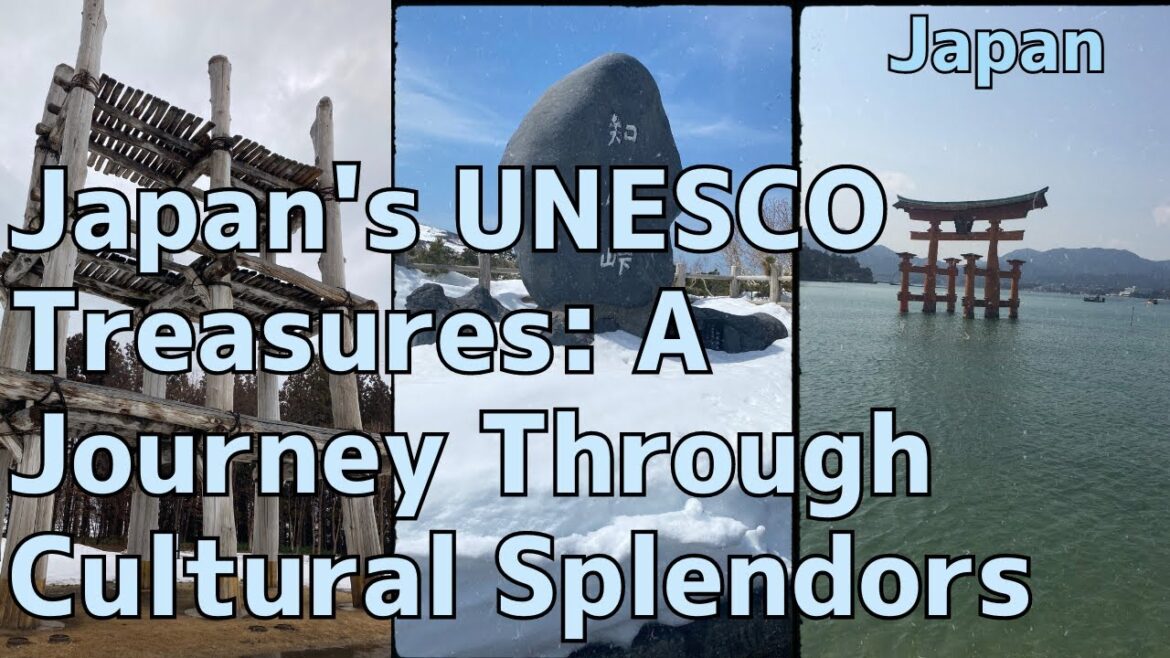Japan’s UNESCO Treasures: A Journey Through Cultural Splendors
Welcome to a land where tradition meets transcendence—Japan, a country adorned with UNESCO World Heritage Sites that bear witness to centuries of history, craftsmanship, and natural wonders. Join us on this virtual tour as we unravel the stories behind Japan’s UNESCO treasures, from ancient temples and shrines to pristine natural landscapes that whisper the secrets of the past.
1. Kyoto: Historic Monuments of Ancient Kyoto:
Our journey begins in Kyoto, the cultural heart of Japan. The Historic Monuments of Ancient Kyoto comprise 17 UNESCO-listed sites, including Kinkaku-ji (Golden Pavilion), Gion District, and Kiyomizu-dera. Each site reflects the city’s rich cultural legacy, from the opulent beauty of imperial palaces to the serene ambiance of Zen gardens.
2. Nara: Historic Monuments of Ancient Nara:
Nara, Japan’s first permanent capital, hosts a collection of UNESCO treasures, including Todai-ji, a monumental temple housing a colossal Buddha statue. The serene Nara Deer Park, where Sika deer roam freely, adds a touch of natural charm to this cultural haven, connecting visitors with Japan’s spiritual and historical roots.
3. Himeji: Himeji-jo Castle:
The iconic Himeji Castle stands as a testament to Japan’s feudal past. This towering fortress, also known as the White Heron Castle, is a masterpiece of wooden architecture, featuring a complex network of defensive structures. The castle’s elegant design and strategic layout have earned it a UNESCO designation, making it a must-visit for history enthusiasts.
4. Nikko: Shrines and Temples of Nikko:
Nestled amidst the scenic beauty of Nikko National Park, the Shrines and Temples of Nikko are a harmonious blend of Shinto and Buddhist architectural styles. Toshogu Shrine, the final resting place of Tokugawa Ieyasu, is adorned with intricate carvings and vibrant colors, showcasing the ornate craftsmanship of the Edo period.
5. Hiroshima: Atomic Bomb Dome and Itsukushima Shrine:
Hiroshima’s Peace Memorial, known as the Atomic Bomb Dome, stands as a poignant reminder of the devastating events of 1945. Recognized by UNESCO for its historical significance, the dome is a symbol of peace and resilience. Nearby, Itsukushima Shrine on Miyajima Island adds a spiritual dimension with its iconic “floating” torii gate.
6. Mount Fuji: Fujisan, Sacred Place and Source of Artistic Inspiration:
Mount Fuji, an iconic symbol of Japan, is not only a majestic peak but also a sacred site revered in Shintoism. Its symmetrical beauty has inspired artists for centuries. The surrounding cultural landscape, including shrines, lakes, and the traditional thatched-roof villages of Oshino Hakkai, adds to the allure of this UNESCO-designated area.
7. Ise: Sacred Sites and Pilgrimage Routes in the Kii Mountain Range:
The Kii Mountain Range, a spiritual haven, is home to three sacred sites: Kumano Sanzan, Koyasan, and the Ise Grand Shrine. These interconnected sites form a network of pilgrimage routes where nature intertwines with religious practice. The Ise Grand Shrine, dedicated to Amaterasu, the sun goddess, is a pinnacle of Shinto architecture and spirituality.
8. Yakushima: Yakushima:
Yakushima, an enchanting island off Kyushu’s coast, is a UNESCO-listed natural wonder. Its ancient cedar forests, including Jomon Sugi, a tree over 2,000 years old, transport visitors to a primeval realm. The island’s lush landscapes, waterfalls, and diverse flora make it a haven for nature lovers seeking tranquility.
9. Shirakawa-go and Gokayama: Historic Villages of Shirakawa-go and Gokayama:
Nestled in the mountains of central Japan, Shirakawa-go and Gokayama are picturesque villages known for their traditional gassho-zukuri farmhouses. These thatched-roof houses, designed to withstand heavy snowfall, create a stunning winter scene that transports visitors to a bygone era, earning these villages UNESCO recognition.
10. Ogasawara Islands: Ogasawara Islands:
The Ogasawara Islands, a remote archipelago south of Tokyo, offer an untouched natural paradise. With diverse marine life, coral reefs, and endemic species, this UNESCO site is a haven for ecotourism. The islands’ unique ecosystems and stunning landscapes make them a sought-after destination for those seeking a pristine and immersive nature experience.
Conclusion:
As we conclude our journey through Japan’s UNESCO World Heritage Sites, the beauty, diversity, and cultural richness of this nation are unveiled. Subscribe for more explorations into the wonders of Japan, and let us know in the comments which UNESCO site captured your imagination. Arigatou gozaimasu, and see you on the next adventure in the Land of the Rising Sun!
#japan #mustvisit #osaka #tokyo #hokkaido #shiretoko #unesco #heritage

